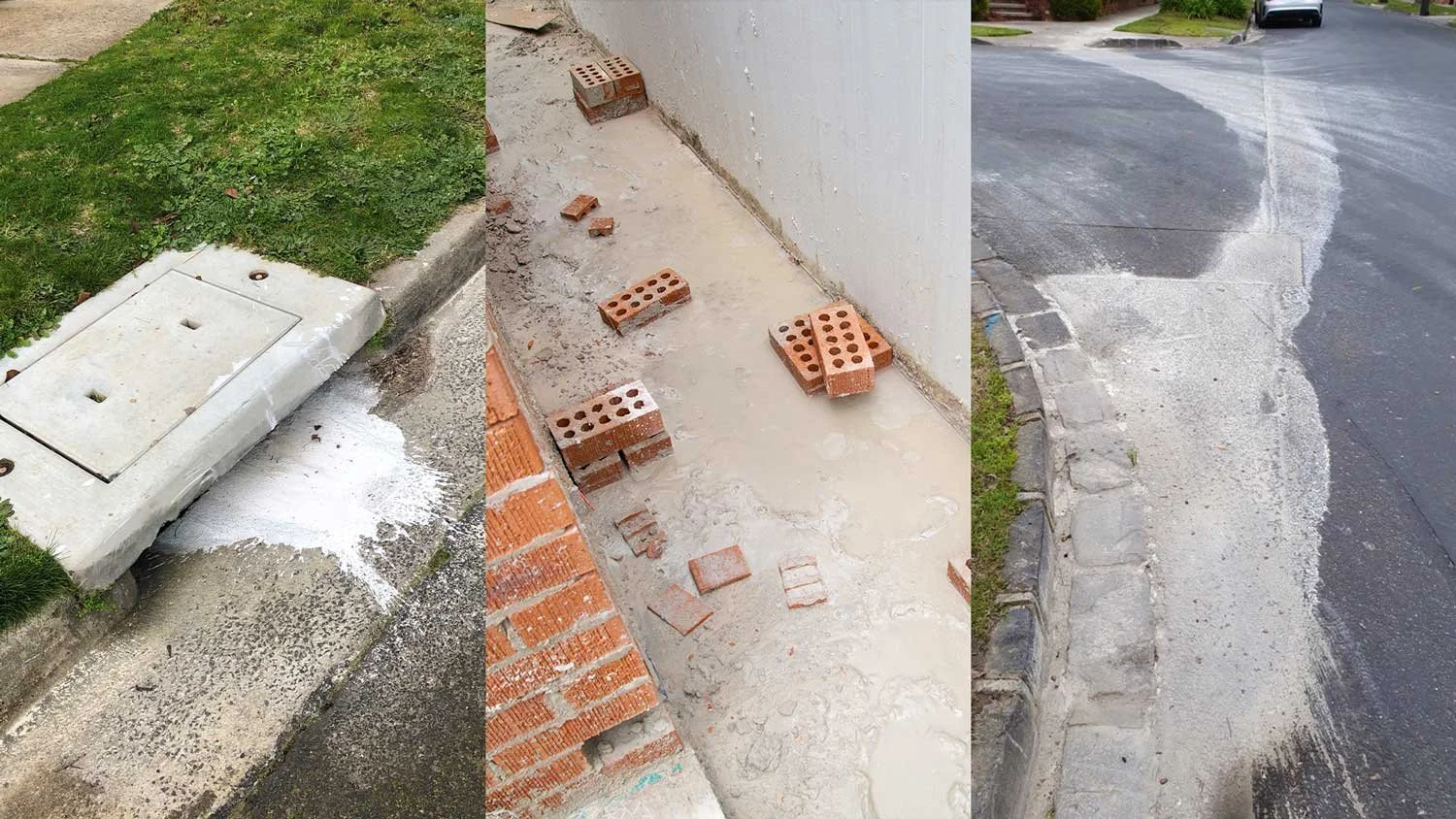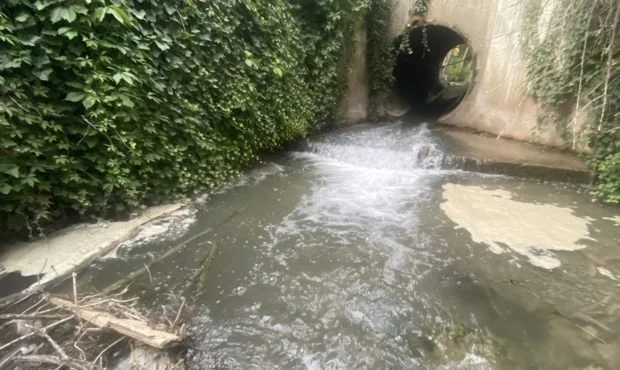THE AUSSIE INNOVATION CLEANING BUILDING SITES & WATERWAYS: ANGUS HUDSON FROM SLURRYTUB
Wet trade slurry (eg. cement slurry) is generated on building sites every day, often finding its way into water systems. For one experienced Sydney builder, it was a problem he’d observed far too often. He had enough of seeing tradespeople cutting corners on site, and dumping slurry out. Often ending up down stormwater drains, out into rivers, and eventually to the ocean. So he created a bright orange solution to this grey problem.
For the sixth episode of our Pitchfest 2022 Series on the Ocean Impact Podcast, we chatted to SLURRYTUB founder Angus Hudson about their innovative - but deceptively simple - solution that allows tradespeople to clean their job site right with the planet in mind.
SLURRYTUB produces an Australian-made, portable filtering system that provides a simple and cost-effective environmental solution for the disposal of wet trade slurry, or cement slurry, from the wash up of cement, concrete, grouts, render, etc.
The Sydney-based startup received multiple nods at INNOVOCEAN for Pitchfest 2022. They were announced 1st Runner Up of the NSW Ocean Innovation Award and 2nd Runner Up for The Ocean Impact Pitchfest 2022 overall.
Pictured: Laura Wells, Tim Silverwood, and Hon. James Griffin MP Minister for Environment and Heritage presenting Angus Hudson with his NSW Ocean Innovation Award at INNOVOCEAN.
Angus Hudson is an ocean lover and builder of over 30 years, which made him uniquely placed to address the difficulties faced by tradespeople on building sites when it comes to managing wet trade waste - with a solution that benefits waterways, rivers, and oceans as well.
SLURRYTUB know their customer. Their practical system solves an important problem in an environmentally conscious way, while being cost effective, portable, and easy-to-use.
And they do this while spreading awareness of how the issue impacts waterways and the environment, while still maintaining the sense of humour that is core to their brand (their slogan is “No Wucking Slurries!”).
What is CEMENT SLURRY?
Wet trade slurry is the liquid resulting from the wash up of cement, concrete, grouts, render, and sediment on building sites by tradespeople in wet trades such as brickwork, blockwork, plastering and rendering, and tiling. Wet trades are those that traditionally use materials mixed with water.
Typically, at the end of the day, all tools and equipment such as hand tools, mixers, wheelbarrows, cutting machinery, etc are ‘washed out’ before the slurry sets, and work areas are hosed down.
Now, in theory, you’re not supposed wrongfully ‘dump’ liquid waste from a building site.
But in practise?
Equipment is often cleaned in improvised ‘wash out areas’ including gardens and lawns, or driveways, roads, and gutters - resulting in slurry ending up where it shouldn’t be.
Non-compliant disposal of wet trade slurry, it’s not pretty. Image Credit: SLURRYTUB
Typical SOLUTIONs for managing cement slurry
As Angus mentions in the episode, some builders do nothing.
But many builders, he adds, try to catch the water.
Whether in buckets, or a wheelie bin, or even things like a repurposed kids paddling pool! Unfortunately, catching slurry like this can be difficult, and these fill up quickly and overflow. It’s far from a ‘hands-free’ process to wash up, and it’s safe to say they aren’t designed for use with equipment like wheelbarrows.
cement slurry solidifier
Once captured, the slurry needs to be hardened in order to dispose of it correctly. Cement slurry solidifier is a powdered chemical composite used to turn liquid slurry waste into a disposable solid. This method has to be handled cautiously, as many slurry solidifiers act similarly to high strength hydrochloric acid. And it isn’t exactly simple, needing to be carefully applied using the correct method and ratio for the individual product and use-case. Additionally, not all waste produced by solidifiers is acceptable for landfill.
Hay Bale Wash up areas
‘Best practice’ guidelines are usually published and enforced by locals councils and according to Angus, one such solution is to arrange hay bales in a semi circle, and wash up within those hay bales. But although this is a type of filtering solution, cement particles can easily pass through the hale bales and out onto the street. It’s also impractical, and not great in tight work spaces.
HOW DOES incorrect disposal of cement SLURRY WASTE IMPACT THE ENVIRONMENT?
Mill Creek slurry spill in 2021. Photo Credit: Patrick Fink
When tradespeople wash their tools and equipment, or hose down the area they’re working in, the wet trade slurry can end up in places it shouldn’t. And the consequences are far-reaching, according to SLURRYTUB’s blog post.
Contains nasties: Cement slurry and other wet trade slurry can contain contaminants such as cadmium, zinc, mercury, arsenic etc. Some slurry can even be considered hazardous waste depending on the tool, equipment, and site involved.
Contaminates waterways: Slurry can enter stormwater systems through a drain on the property, or from overflowing onto the footpath or street. being highly alkaline, it can even leech into groundwater systems via vegetation. From there, it flows into local creeks, rivers, and ultimately out to the ocean.
Damages vegetation: In addition to leeching into groundwater systems though vegetation, cement slurry can damage soil due to its high alkalinity, and even hinder plant growth. It can also block stormwater drains which can contribute to flooding during periods of heavy rain, impacting surrounding plant life.
Harms marine life: Cement slurry mixtures can cause high levels of pH in waterways, harming marine life like this large fish kill incident in Utah as a result of a spill into a creek. NSW EPA Executive Director Regulatory Operations Steve Beaman said:
“Many builders and renovators think that sediment and building products going into the stormwater drain won’t have much of an impact. However the sediment from even a single building site can damage local streams and waterways. and when this action is replicated hundreds of times on building sites across the region - it can have a significant environmental impact”
Huge fines/penalties: Improper disposal of cement slurry can fall under ‘illegal dumping’ and the EPA can impose severe penalties for this, such as the $15,000 fine Boral received when their plant discharged slurry into a drain flowing to the Clarence River. Results from the NSW EPA’s “Get the Site Right” inspection blitz in May 2021 saw a total of $383,167 in fines issued to building sites that didn’t meet the standards for preventing runoff from their building sites entering waterways. These fines have consequences on both reputation and the bottom-line, putting businesses at risk.
Not great for humans either: Physical contact with some slurries can cause burns and ulcers, so safe clean up and disposal is important site safety. Depending on the mix, slurry can be caustic, corrosive, and toxic.
Unsightly mess: We’ve all seen it. Unsightly, muddy streaks on the street leading into a stormwater drain from a building site that’s been hosed out onto the pavement. A mound of muck in a quiet corner of someone’s garden or lawn on the edge of the job site. It’s one of the surest ways for builders and tradespeople to attract unwanted attention. Leaving a mess, affecting site safety, and resulting in a very unhappy client.
Cement slurry properly managed and contained on a building site with SLURRYTUB’s filtering system.
The SLURRYTUB filtering system
Solution: SLURRYTUB
SLURRYTUB is a simple and cost-effective solution to this major problem in the building industry.
An Australian-made engineered filtering system designed to capture and filter wet trade slurry, creating an environmentally friendly way to clean tools and equipment.
The bright orange tubs are recyclable and heavy-duty, and the cellulose paper filters are biodegradable.
How Does SLURRYTUB Work?
SLURRYTUB in action. Image credit: SLURRYTUB
The filter separates slurry as the tub is filled, capturing solids/sediment while draining away visibly clear water within designated washout area, or for recycling on the job. The hardened waste captured in the filter can then be disposed of in a suitable site skip or other appropriate method, along with the filter medium.
It’s clever design allows most wheelbarrows to be supported hands-free by standing it up to empty the slurry into the tub, and resting the barrow’s lip in the tub cut-out, to then be easily washed out. Because it’s so portable, it can be used by a variety of trades and in a variety of situations; fitting on even the tightest job sites.
The tub’s drain fits a standard garden hose too, making it easy to capture water for recycling on the job. SLURRYTUB states on their website that lab tests have shown the system can filter water to better than Australian Drinking Water Guidelines, other than for pH and Chromium.
The process of using a SLURRYTUB to manage wet trade slurry, from start to finish.
Advice for innovators
OIO Co-founder Tim Silverwood and SLURRYTUB Founder Angus Hudson at our INNOVOCEAN showcase event in 2022
When asked what advice he’d give to those innovative ocean lovers who are tinkering with solutions in garages and sheds, Angus recalled the moment he decided to try and fix a process that was clearly broken.
See a problem? Find a solution.
“I remember the actual moment I thought I was going to develop a product, was when I turned up at a building site. I saw a wheelbarrow lying on its side. I saw slurry all over the ground. And I thought ‘I’ve gotta help with with this problem.’”
Make sure it’s the right solution
“From having that thought, it took about 2-3 years to actually start doodling on paper, designing things, and coming to the conclusion that you could design something [to solve the problem]. So I think a key part for me was to actually keep developing, keep developing, keep developing until you’re actually satisfied that you have the right solution for the problem.”
Listen and Watch
New episodes of the Pitchfest 2022 Series will be releasing each week. Follow the Ocean Impact Podcast wherever you get your podcasts, or subscribe and watch on Youtube.










